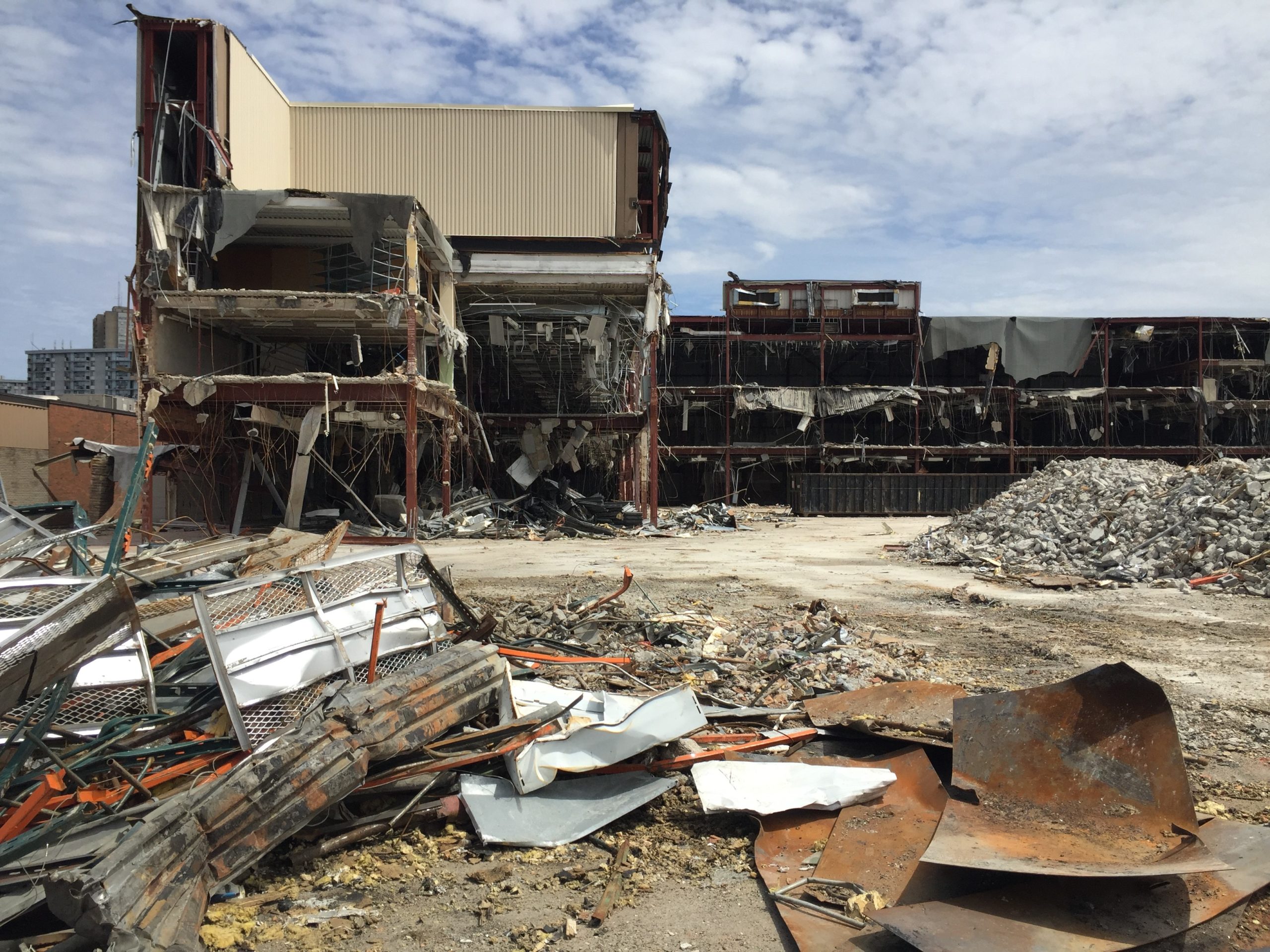National Trust Endangered Places List – Special Climate Crisis Edition
The greenest building is the one already built – Carl Elefante
On the eve of Earth Month, the National Trust for Canada is bringing attention to the connection between climate and heritage conservation by naming a handful of places facing demolition to the Endangered Places List. Trashing structures and their materials is a luxury that Canada can no longer afford. With the climate emergency and biodiversity loss the most pressing issues of our time, and the Worldwatch Institute estimating that the planet will have run out of many raw building materials by the year 2030, every decision about the future of an existing building needs careful scrutiny.
Heritage and climate advocates can agree that the loss of these places would send a strong message about the premature obsolescence and disposability of existing buildings – regardless of heritage status, age or personal taste. Without action, people, places and planet are at increasing risk of devastating climate impacts.
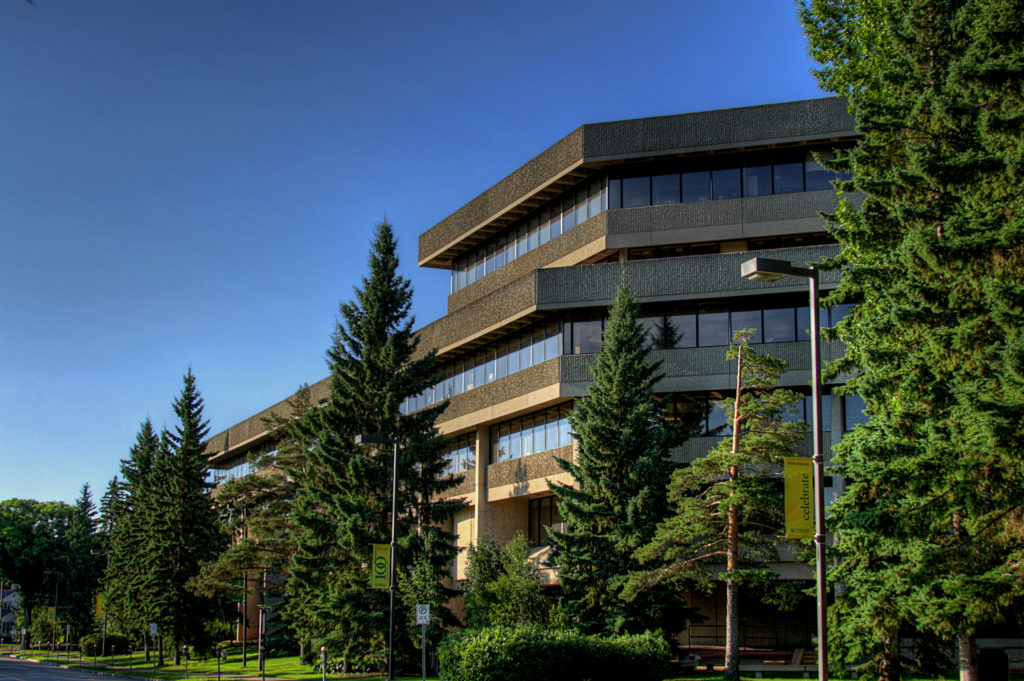
1. Humanities Centre, University of Alberta
(11121 Saskatchewan Drive, Edmonton, AB)
The University of Alberta (U of A) is currently on an unprecedented demolition spree. Spurred by huge provincial cuts to university funding beginning in 2019 and its desire to remove deferred maintenance liability ($865 million in 2020) from its books, the university has demolished hundreds of thousands of square feet of buildings since 2019: Alumni House (1959); the vast 380-unit Michener Park student housing complex (1967); the four historic Ring Houses (1912-14, included on National Trust Endangered Places List 2021); and the Dairy Barn or Faculty of Agriculture, Life, and Environmental Sciences Museum (1930). The Administration Building (1957) and Humanities Centre (1972) are next to face the wrecking ball, with more rumoured to follow. The Humanities Centre, designed by renowned Edmonton architect John McIntosh, is a striking Brutalist structure in the inverted ziggurat style, with light-filled atriums, boldly textured finishes, and expressive features like a circular lecture hall pod.
In April 2022, the Times Higher Education Impact Rankings named the U of A as one of the world’s top 15 most sustainable post-secondary institutions for its ongoing efforts creating sustainability on campus and beyond. Instead of discarding buildings, the University of Alberta should be demonstrating climate leadership by adapting its legacy public assets.
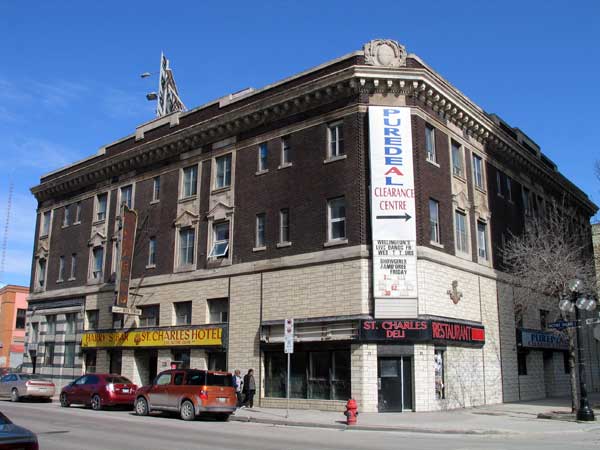
2. St. Charles Hotel
(235 Notre Dame Avenue, Winnipeg, MB)
For the past 15 years, the St. Charles Hotel has been a very prominent victim of demolition by neglect. Located at a high-traffic entry point into Winnipeg’s iconic Exchange District National Historic District, the St. Charles Hotel (opened in 1913) is a 4-storey brick and stone structure that has served various roles as a hotel, restaurant, and nightclub venue, and received a City of Winnipeg heritage designation in 1985. Following its purchase in 2005, the new owner gutted the interior and tried to demolish the building for a boutique hotel in 2008. The City refused the demolition request and the building has sat empty ever since, with new development plans being floated sporadically. In 2013, the City, frustrated by the public safety issues around the St Charles Hotel, moved to seize the property by declaring it derelict, but ultimately did not expropriate.
The City’s Vacant Building Bylaw, passed in 2010, was designed to push owners to redevelop such buildings via escalating annual penalties for vacancy. Heritage Winnipeg has called for this bylaw to be amended so there is a firm timeline for expropriation if owners refuse to renovate or sell their derelict buildings. There are examples of this kind of demolition by neglect in every Canadian city: see Somerset House (352 Somerset St. W) in Ottawa, added to the National Trust’s EPL in 2017, which has been a high-profile eyesore since 2007.
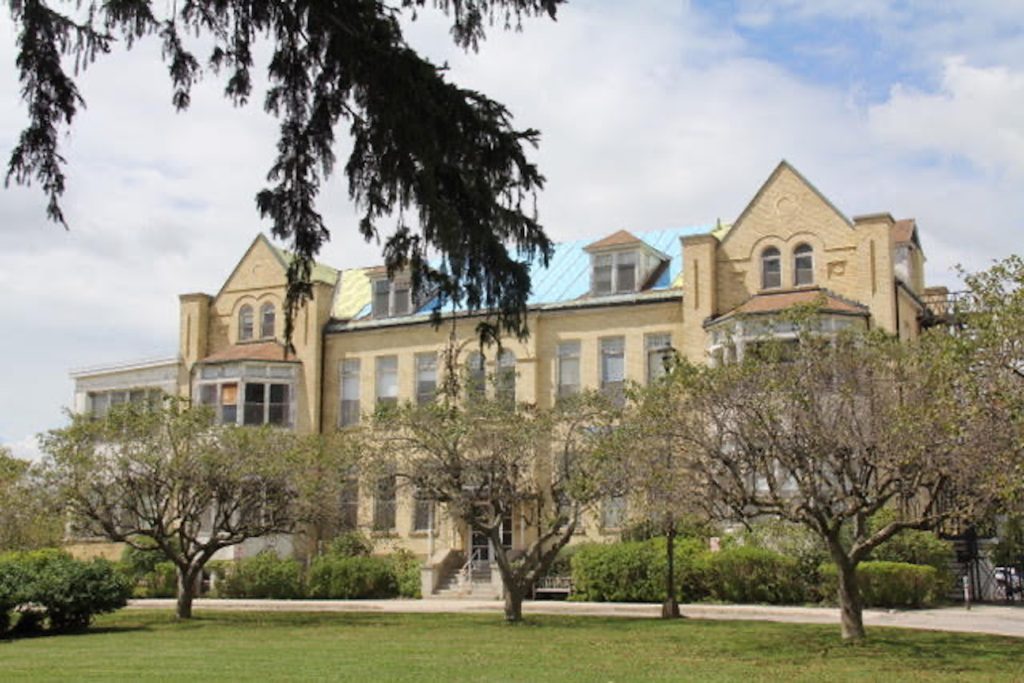
3. Avon Crest Centre for Health and Wellness
(86 John Street South, Stratford, ON)
The Huron Perth Health Alliance (HPHA) is working to demolish a structurally sound building – one of Stratford’s most important architectural landmarks – to ensure clear and unhindered development space for sale to a developer. Opened in 1891 and designed by renowned architect George F. Durand, Avon Crest is Stratford’s first public hospital – one of a handful of surviving 19th century hospitals in Canada. Designed in the High Victorian Queen Anne style with a central tower, bay windows, turrets, and high chimneys in local buff brick, it has lost decorative features over time, and been enlarged with rear additions. In 1955 it was converted to a convalescent home and renamed Avon Crest, and later accommodated administrative functions until abandoned in 2018. Members of the Save Avon Crest Committee have calculated that the embodied carbon in its bricks alone – all 247,000 of them – represents 131,100 kg of carbon.
In 2020, the HPHA , the hospital owners, conducted a brief search for options around reusing the hospital building surrounded by large parking lots, but concluded a “clean site” without the old hospital would be more attractive to developers. On January 31, HPHA posted a request for demolition tenders with a deadline of February 14. Meanwhile, in nearby London, Ontario, two large heritage buildings at the former Victoria Hospital site are in the process of being converted to affordable rentals by non-profit housing developers.
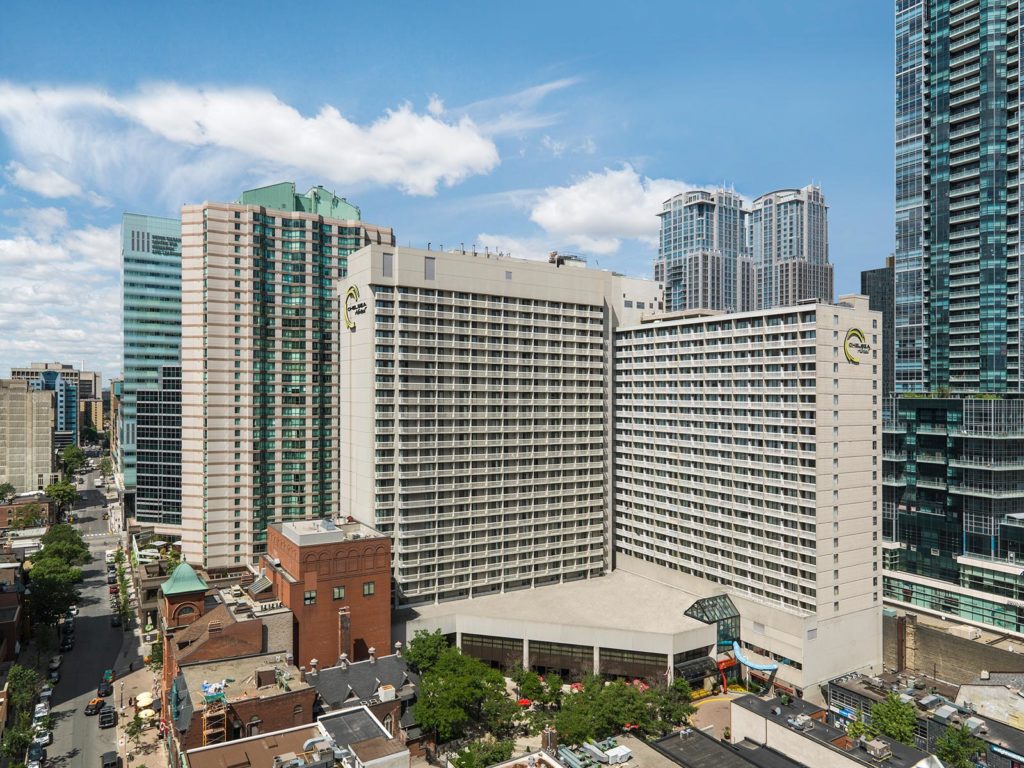
4. Chelsea Hotel
(33 Gerrard Street W., Toronto, ON)
Opened in 1975, the Chelsea Hotel – Canada’s largest hotel with 1,590 guest rooms spread over 26 storeys – is slated to be completely demolished and replaced with three glass towers approximately 31, 49, and 86 storeys in height. The proposed new tower complex promises to more than triple the floorspace on the site. The Chelsea Hotel represents a gigantic material legacy (hundreds of thousands of cubic metres of concrete alone), is well-maintained and structurally sound, and could easily be adapted and expanded. Constructed with CMHC funding as a student housing cooperative and residential condo building, it ultimately opened in 1975 as Delta’s Chelsea Inn with approximately 45,000 m2 of residential and conference space. The massive Brutalist structure was evaluated for heritage significance by the City of Toronto and ultimately not recognized – but heritage and climate advocates cannot ignore the message this demolition would send about the premature obsolescence and disposability of existing buildings.
Why it matters:
Trashing these structures and their building materials is a luxury that Canada can no longer afford. With the climate emergency and rapid biodiversity loss the most pressing issues of our time, and the Worldwatch Institute estimating that the planet will have run out of many raw building materials by the year 2030, every decision about the future of every existing building needs careful scrutiny.
Canada shamefully leads the world in per capita garbage production – 36.1 tons per person (the US is at #3 with 25.9 tons) – with construction and demolition waste estimated to be at least 27% of our waste stream. An estimated 2,752,000 tons of wood CRD waste, much of it irreplaceable old-growth lumber goes into landfill. Vancouver for instance saw 23,485 of 68,000 single-family homes in the city demolished between 1985 and 2014.
The construction and building operation sector is the world’s largest single source of energy use and emissions – 39% of the carbon footprint worldwide – and offers the opportunity for dramatic decarbonization returns. While most carbon mitigation efforts focus on reducing emissions from building operations (28% of emissions), the carbon in building materials represents 11% of embodied emissions. The greatest GHG and environmental impact reductions can be achieved by extending the life of existing buildings and reusing them in situ – “the greenest building is the one that already exists” – and creating new durable buildings capable of adapting to new uses over time. Rewards would not only include carbon emission savings, but also the avoided impact of resource extraction on natural heritage and Indigenous cultural landscapes. Canada has a vast carbon sink of older or heritage buildings to maintain and capitalize upon. In contrast, studies have established that it takes up to 80 years for a new “green” building to overcome the carbon impacts of its construction. Without action, people, places and planet are at increasing risk of devastating climate impacts.
What needs to change:
We are in the midst of a climate crisis and immediate action is paramount. Canada needs policies that will have immediate positive impacts on GHG emissions – and also create jobs and a strong economy. The recycling and re-use of existing buildings, our largest consumer good, offers an exceptional and largely ignored opportunity to achieve these goals.
However, building reuse is still not the norm in Canada, with resource- and carbon-intensive demolition and construction of new buildings offering the path of least resistance for the construction industry and for buyers. The barriers to reuse take many forms, including:
Regulatory barriers – zoning, planning regulations, and prescriptive rather than performance-based building codes can stifle reuse and drive neglect;
Physical or Technical barriers – building rehab costs inflated by deferred maintenance, or limited availability of heritage professionals to reveal reuse opportunities and reduce risk;
Cultural barriers – construction industry practice is biased to new construction, and the real estate market practice perpetuates premature building obsolescence; and
Economic barriers – obtaining bank financing for adaptive reuse can be challenging, and property tax and income tax treatment spur demolition.
Disincentivizing demolition and accelerating building reuse and retrofit through financial incentives, stricter demolition permit review, and the requirement for Whole Life Carbon Accounting (WLCA) in development decisions, offers a crucial pathway to achieving Canada’s climate goals. Spurring the reuse and retrofit of older/heritage buildings also reduces the impact on the environment (including Indigenous cultural heritage) of unnecessary resource extraction.
Recommended actions:
All citizens can take action in our communities. Ask your municipal councilor about new tools to make building reuse the new normal, such as: curbing “as a right” demolition permits and strengthening demolition review policies; prioritizing materials conservation by requiring deconstruction if demolition is unavoidable; creating more building reuse incentives, including priority planning approval for reuse projects; creating vacant building by-laws that spur owners of derelict buildings to invest or divest.
Governments, Institutions, and the Private Sector can ensure that the material value of older buildings is recognized, and climate impact of building reuse versus new construction duly considered, by requiring Whole Life Carbon Accounting (WLCA) in their laws, regulations, and policies affecting construction and demolition.
Federal and Provincial-Territorial Governments can contribute significantly to Canada’s decarbonization goals by correcting biases in their tax systems that make premature building demolition attractive. For example, the federal government can update terminal loss, capital gains, and recapture of depreciation provision. Provincial-territorial governments should address property tax measures encouraging demolition.
The Federal Government can introduce a new tax incentive modelled on the US Federal Historic Preservation Tax Incentive to encourage the private sector to invest in the rehabilitation and reuse of older and heritage buildings.

